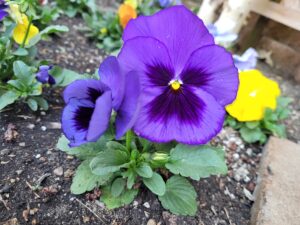(by Shirley Mah Kooyman) The IHA (International Herb Association, www.iherb.org) has been selecting an “Herb of the Year” since 1995 with fennel as the first herb to be highlighted. For this year, Viola has been chosen as the 2022 Herb of the Year to showcase its special qualities. An herbal candidate, chosen for the honor of being Herb of the Year, has to qualify in at least 2 of 3 criteria. The criteria are: culinary, medicinal, and ornamental. Viola fits the bill for all 3. Viola, the genus for violets, consists of about 600 species in the Violet family (Violaceae) The genus is concentrated mostly in temperate areas in the Northern Hemisphere, thriving in cool weather conditions. There are about 25 genera in the family. Viola is only one of those. Violas can be caulescent (with above ground stem) or acaulescent (without above ground stem) herbaceous annuals or perennials. There is even a woody shrub violet (Viola arborescens) which is endemic in the Algarve region of Portugal. It also occurs on Cape Trafalgar in Spain. Other common names for the V. arborescens are woody violet and European tree violet. The herbaceous violas generally are grown in the garden because of their ornamental flowers. Although Viola is the genus, it is often used interchangeably as a common name along with violet, heartsease, Johnny-Jump-Up, etc. What’s a pansy and what’s a violet ? They are all in the genus Viola. The major difference between the two is the size of the plant. The term pansy generally refers to the larger, showier flowers bred for garden displays, while viola and violet refer to the smaller-flowered ones. In essence pansies are violas on steroids. Violas frequently have heart-shaped leaves, but can also have linear or palmate leaves. The flower colors range from white, yellow, blue, oranges, violet and multi-colors. There are several ways of reproduction. First, there are the opened flowers seen in spring. These are pollinated by insects. Then, there are also unopened flowers (cleistogamous flowers) borne low to the ground that are self-pollinated. Thirdly, there are the asexual methods of plants breaking apart that can develop into new plants. The seeds are dispersed by being ejected from the fruit capsule to as much as 5 ½ yards. The seeds have a fleshy structure on its exterior called elaisomes which are full of lipids and proteins. The elaisomes are very attractive to ants for feeding their larvae. They carry the seeds to their nests. Once the elaisomes are consumed the seeds are carried out of the underground nests and dispersed above ground far from the nests. Thus, the seeds get moved some distance from the mother plant and germinate afar. Myrmecochory is the term used for the dispersal of fruits and seeds by ants. Many other plants aside from Viola have such a symbiotic relationship with ants. Violas thrive in a variety of habitats. They’re found in bogs, dry prairies and woodlands. They are cool season flowers that can handle unexpected spring snowfalls. The plants fade in high temperatures. Violas are used as food sources by larvae of some butterflies and moths. Many Fritillary butterfly larvae are dependent on violets as a host plant. There are many uses for Viola such as medicinal, perfumery and food. Because of their anthocyanins, viola species have shown to have antioxidant capabilities and have medicinal value. In the perfume world, Viola odorata is the source of the scents. In the culinary arena the young leaves are eaten raw in salads or cooked as a leaf vegetable. A Viola liquor is also made and often added to champagne. Essential oils are extracted and added to soap, body lotion, honey, teas and cookies. The flowers can be made into a syrup for pancakes or candied and used in a variety of ways. Toulouse, France is known as City of Violets. Violets have been cultivated in Toulouse since the 1850s, drunk as liquor, eaten as crystallized flowers and is an emblem of the city. The crystallized flowers are still commercially made there and are known as Violettes de Toulouse. As a side note there is a Violet Festival in Toulouse every year in February. For more information check out www.frenchduck.com In Minnesota Violas are planted in flower beds and containers as annuals in early spring to be replaced with warm season annuals when the summer heat rolls in by late June. Native violets bloom profusely in the woodlands along with spring ephemerals. Most violas start to look worn and unhappy when the weather gets too hot. However, the cultivar ‘Etain’ is a pretty little perennial violet bred to tolerate the summer heat.2022 Herb of the Year - Viola (Viola sp.)
Here are 2 recipes for using viola flowers:
To make violet syrup: (From Euell Gibbons in his Stalking the Wild Asparagus book or on the internet www.herbanlifestyle.wordpress.com)
Steep 1 cup violets in 1 cup boiling water for 24 hours. Strain flowers. Put strained violet juice in sauce pan. Add juice of ½ lemon and 2 cups sugar. A little chemistry lesson will occur changing the blue juice to pink. Bring to a boil, simmer for 10 minutes. Serve on pancakes.



